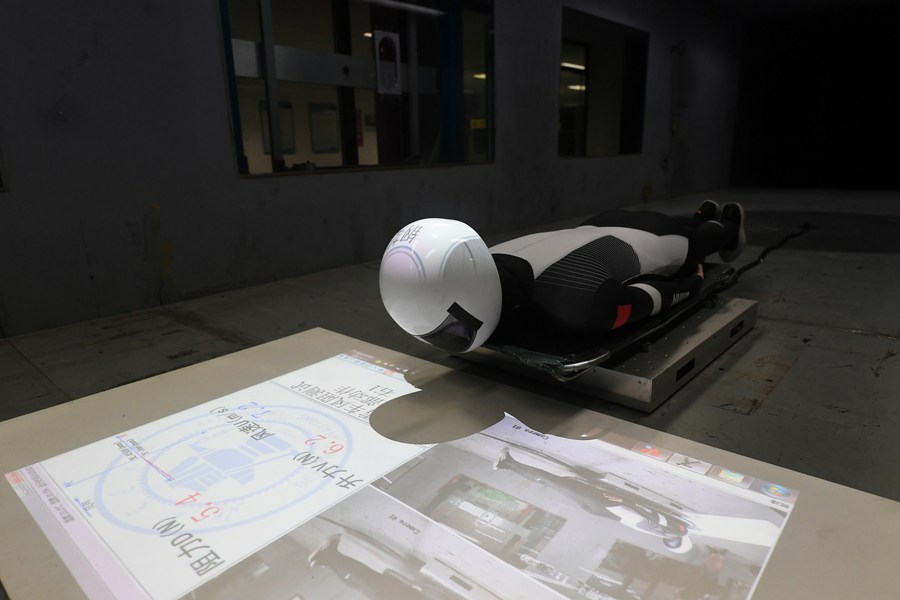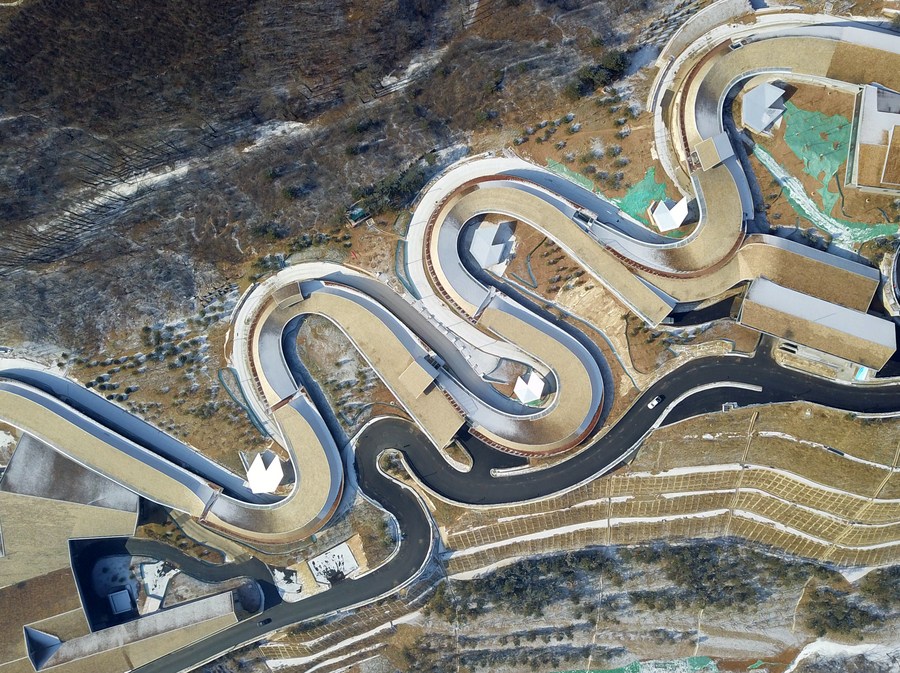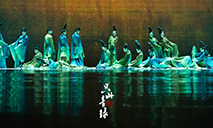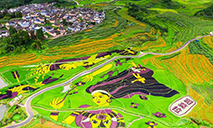Technology provides training muscle for Beijing Winter Olympics

A training system based on wind tunnel at Beijing Jiaotong University sends real-time data including speed, wind resistance and posture to a tester on July 16, 2021.(Xinhua/Ren Chao)
BEIJING, Aug. 30 (Xinhua) -- Chinese researchers have joined forces to prepare venues, gear, and athletes' training facilities for the Beijing Winter Olympics coming up in 2022.
VENUE
In 2018, researchers and students from the wind tunnel lab at Beijing Jiaotong University joined the construction efforts of the Winter Olympic venues.
The National Alpine Ski Center, one of Beijing 2022's most technically challenging venues, was built more than 1,200 meters above sea level on Xiaohaituo Mountain in the Yanqing competition zone.
At the foot of the Alpine Ski center, a sliding track for bobsled, luge, and skeleton at the 2022 Games winds down the mountain, ready for the world's best pilots to display their courage and skills in disciplines often dubbed "Formula 1 on ice."
The 1.9-km sliding center, the first of its kind in China, features 16 angled curves to resemble a mythical Chinese dragon.
"The Yanqing competition zone has complex terrain and strong wind," said Li Bo, a professor at Beijing Jiaotong University. "Wind resistance is key to the construction of buildings and temporary facilities.
Li and his team from the wind tunnel lab studied the wind field data in the Yanqing competition zone and used tunnel tests to assist in the design of the Olympic venues.
According to Qiu Jianbing, the design leader of the sliding center, the facility at the Yanqing competition zone is located on the mountain's southern slope. The design team developed a system combining the terrain, awning, and sunshade to reduce the impact of solar radiation.
They analyzed the sun's height in spring, autumn and winter, and used computer models to simulate and determine the awning and sunshade coverage on the track. Now, harsh sunlight will not be an issue for athletes' training and competition.

Aerial photo taken on Jan. 19, 2021 shows the National Sliding Center in Yanqing District, Beijing, capital of China. (Xinhua/Zhang Chenlin)
GEAR
Last month, the first bobsleigh developed in China was exhibited in Shougang Park, the Beijing 2022 Olympic and Paralympic Winter Games headquarters.
In the Winter Olympics, Bobsleighing, a traditional sporting event, has been largely dominated by Western teams.
As a late comer, the Chinese team has been relying on imported sleighs for training and competitions. A research and innovation consortium of 12 industry units was established to make the Chinese bobsleigh from scratch.
China's space technologies played a role in developing the country's first homemade bobsleigh. The China Academy of Launch Vehicle Technology chose carbon fiber composite material to make the bobsleigh lighter, and used streamlined design to fit the body shape of Chinese athletes.
The sleighs went through wind drag tests at the China Academy of Aerospace Aerodynamics (CAAA), and their shapes have been optimized to experience lower resistance and higher speeds.
The homemade sleighs have an 8 percent lower wind drag, significantly boosting athletes' performance. The sleigh is expected to be delivered to Chinese athletes in mid-September and make its debut in the 2022 Beijing Winter Olympics.

Researchers from the wind tunnel lab at Beijing Jiaotong University discuss their experiment plan on July 16, 2021. (Xinhua/Ren Chao)
TRAINING
Finding the most aerodynamic position is vital for athletes across many sports, and many use wind tunnels to train.
Testing performance in the wind tunnel can help optimize sportswear and equipment to reduce drag, and help athletes find their "winning postures."
Zhang Yuanzhao, a member of the wind tunnel lab of Beijing Jiaotong University, said that more than 10 national Winter Olympics teams had completed wind tunnel tests and data analysis at the lab as of mid-July.
The CAAA also developed a wind tunnel to help train Chinese athletes for the 2022 Winter Olympics. The maximum wind speed in the tunnel is 42 meters per second.
A 6 DoF (degrees of freedom) skeleton sled training system has been developed with the help of virtual reality and digital simulation technologies.
The system, which gives athletes the feel of training on an actual track, can calculate the gravity, wind resistance, and track friction data in real time and help athletes form muscle memory at turnings.
Photos
 Dance show saluting traditional culture of the Song Dynasty makes its debut
Dance show saluting traditional culture of the Song Dynasty makes its debut Village in SW China’s Yunnan embraces prosperity through agricultural tourism
Village in SW China’s Yunnan embraces prosperity through agricultural tourism Eighth birthday for pair of giant pandas celebrated in Haikou, Hainan province
Eighth birthday for pair of giant pandas celebrated in Haikou, Hainan province Olympic gold medalists portrayed in Shanxi artist’s polymer clay sculptures
Olympic gold medalists portrayed in Shanxi artist’s polymer clay sculptures
Related Stories
- Slovakia men's ice hockey team qualifies for Beijing 2022
- Beijing speeds entry of equipment for Games
- Use of new tech in UN peacekeeping should respect sovereignty of host countries -- Chinese envoy
- Beijing plans strict virus control as Winter Games approach; indoor spectators, booster shot for workers 'not ruled out’
- Ceremony for 200 days countdown to Beijing 2022 Paralympic Winter Games held in Shougang Park
Copyright © 2021 People's Daily Online. All Rights Reserved.






